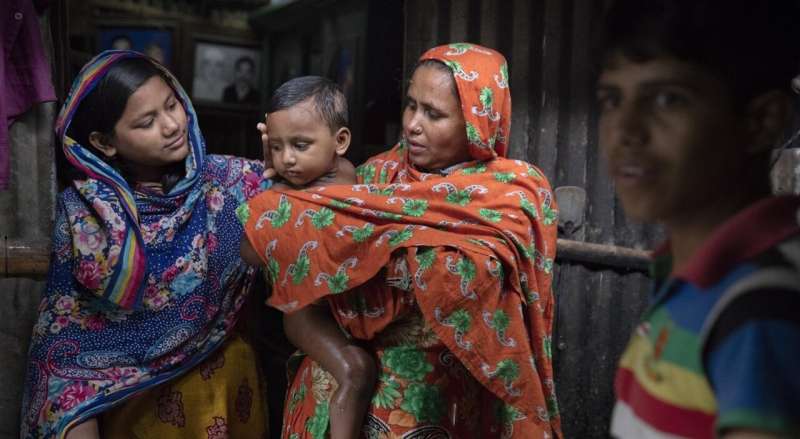This article has been reviewed according to Science X's editorial process and policies. Editors have highlighted the following attributes while ensuring the content's credibility:
fact-checked
trusted source
proofread
Early childhood health interventions have 'big, multigeneration impacts,' research finds

It was the late '90s, and Tania Barham, future associate professor of economics at the University of Colorado Boulder, was in Yemen, working as an economist for the World Bank, which had teamed up with UNICEF to improve that country's health, education and water.
Like the World Bank and UNICEF, Barham believed she was helping people, making a positive difference in their lives. But something was missing.
"I had a moment where I'm like, 'There's almost no evidence,'" Barham recalls. "There was little data to understand if a project was successful or not in terms of development."
It was a life-changing realization, one that convinced Barham to go back to school, earn her Ph.D. and research how to bring people out of poverty over the long term.
Unique data
Much of Barham's work draws upon data from Bangladesh.
In the '70s, Barham explains, the Bangladeshi government rolled out the Maternal and Child Health and Family Planning Program (MCH-FP) in the Matlab area, a rural pocket of land just east of the Meghna River.
The purpose of this program was twofold: to provide a basic health care package for impoverished families—including family planning, nutritional rehabilitation and vaccinations—and to do so in a way that allowed researchers to study the program's effectiveness.
"They wanted to see if this thing worked," says Barham.
One way the program designers did this was by setting up a control area and a treatment area, so that different health outcomes between the two could be traced back to the interventions. Another was by keeping detailed records of the specific individuals and families who received the treatments.
"They kept regular demographic surveillance data, and then they would do census of the study areas every so often," says Barham.
This surveillance data shows a number of things: if someone migrated or married, if someone died, if over time there have been any changes in household structure. And it goes deep.
"We could link everybody back to their original household from before the project began," says Barham.
So rich is this data that Barham and fellow researchers were able to conduct follow-up surveys of the treatment subjects starting in 2012, decades after MCH-FP began.
Barham wanted evidence, but this was more than she could have ever hoped for.
"This data doesn't exist almost anywhere else."
The effects
In a paper now under review, Barham and co-authors Brachel Champion, Gisella Kagy and Jena Hamadani explore the effects of MCH-FP on human capital.
Human capital, says Barham, refers to how equipped a person is to be successful in life. "It's a person's education. It's their health. It's their cognition. It's their ability to solve problems. It can be social-emotional skills too."
In other words, to improve a person's human capital means to improve that person's chances of escaping poverty or avoiding it in the first place.
Barham and her colleagues found that those in the Matlab area who received treatments showed increased height, a sign of improved health. They also found that kids in the treatment area exhibited improvements in cognition and, among the males, higher education and higher math scores.
But the most important finding, says Barham, was that these effects spanned generations. The second generation benefitted as much as the first. The human-capital gains were ongoing.
In another paper, this one published in December 2023 in the Journal of Human Resources, Barham and co-authors Randall Kuhn and Patrick S. Turner describe how MCH-FP affected migration.
Traditionally, many men in the Matlab region have migrated to Chittagong or Dhaka for work, or sometimes farther afield to countries like Qatar, where the higher-paying jobs are. But MCH-FP interrupted this narrative.
"We thought we would find some traditional thing—you improve people's education, and they go and get better jobs, and they still migrate to get them," says Barham. "But that wasn't the story we found at all. It was actually, I think, a more exciting story."
Barham, Kuhn and Turner found that, instead of migrating, the Bangladeshi men were getting better jobs at home and therefore staying with their families.
"This is so important," says Barham. "We see so much migration happening in the world right now, and here is an example which you almost never see of a program where people decided to stay."
The big takeaway from both papers, says Barham, is that even a modest health package can have "big, multi-generation impacts."
The big picture
Barham's ultimate goal is to help those living in poverty, especially children.
"I care about people having the best start to life. Because if you don't have a good start to life, it's just that much harder to be successful later on."
Now, propped up on decades of data and research, she hopes to spread the word and encourage investment in programs similar to MCH-FP.
"Good interventions help, and they accumulate," she says. "We have to tell that story."
More information: Improving the Early Childhood Environment: Direct and Distributional Effects on Human Capital for Multiple Generations. ibs.colorado.edu/barham/PAPERS … ultigenerational.pdf
Tania Barham et al, No Place Like Home, Journal of Human Resources (2023). DOI: 10.3368/jhr.0322-12209R2




















